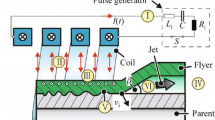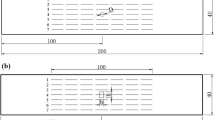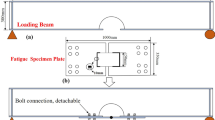Abstract
The residual stress produced in plasma transferred arc welding (PTAW) has strong effects on the service performance of remanufacturing components. In this study, a novel non-destructive testing method based on spontaneous magnetic signals is used to characterize the residual stress in PTAW. Experimental results show that both magnetic signal tangential components Hp(x) and normal components Hp(y) can locate the high residual stress zones from the welded specimen. A new characteristic value Hp is proposed to reflect the residual stress distribution, and its average value Hpa is further calculated to quantify the residual stress level. The characteristic value Hpa increases exponentially with an increase in average residual stress σa paralleled to the cladding coating, whereas it decreases linearly perpendicular to the cladding coating. Except for the temperature gradients, the various phases with different material mechanical properties may lead to different volume shrinkage during cooling process, which is the possible reason underlying the high residual stress and large magnetic field at heat affected zone (HAZ).
















Similar content being viewed by others
References
Deng DW, Chen R, Zhang HC (2013) Present status and development tendency of plasma transferred arc welding [J]. J Mech Eng 49(7):106–112
Yelbay HI, Cam I, Gür CH (2010) Non-destructive determination of residual stress state in steel weldments by magnetic Barkhausen noise technique [J]. NDT&E Int 43:29–33
Dong LH, Wang Y, Guo WL (2014) Stress measuring techniques and applications in remanufacturing field [M]. National Defense Industry Press, Beijing
Wang W, Yi SC, Su SQ (2016) Experimental investigation of stress and damage characterization of steel beam buckling using magnetic memory signals [J]. Struct Design Tall Spec Build 25(11):505–518
Li HM, Chen ZM (2016) Quantitative analysis of the relationship between non-uniform stresses and residual magnetizations under geomagnetic fields [J]. AIP Adv 6(7):401–406
Roskosz M, Bieniek M (2012) Evaluation of residual stress in ferromagnetic steels based on residual magnetic field measurements [J]. NDT&E Int 45:55–62
Wang ZD, Gu Y, Wang YS (2012) A review of three magnetic NDT technologies [J]. J Magn Magn Mater 324(4):382–388
Xu BS, Dong LH (2015) Metal magnetic memory testing method in remanufacturing quality control [M]. National Defense Industry Press, Beijing
Qi X, Di S, Liu H et al (2012) Magnetic Barkhausen noise, metal magnetic memory testing and estimation of the ship plate welded structure stress [J]. J Nondestruct Eval 31:80–89
Liang B, Gong JM, Wang HT, Ye C (2012) Evaluation of residual stresses in butt-welded joints by residual magnetic field measurements [J]. Appl Mech Mater 217-219:2427–2434
Kolokolnikov S, Dubov A, Steklov O (2016) Assessment of welded joints stress-strain state inhomogeneity before and after post weld heat treatment based on the metal magnetic memory method [J]. Welding in the World 60:665–672
Kolokolnikov S, Dubov A, Marchenkov A (2014) Determination of mechanical properties of metal of welded joints by strength parameters in the stress concentration zones detected by the metal magnetic memory method [J]. Welding in the World 58:699–706
Dubov A, Kolokolnikov S (2010) Comprehensive diagnostics of parent metal and welded joints of steam pipeline bends [J]. Welding in the World 54(9–10):241–248
Roskosz M (2016) Capabilities and limitations of using the residual magnetic field in NDT [C]. 19th World Conference on Non-Destructive Testing, Munich
Roskosz M (2011) Metal magnetic memory testing of welded joints of ferritic and austenitic steels [J]. NDT&E Int 44:305–310
Liu B, Chen SJ, Dong SY et al (2015) Stress measurement of laser cladded ferromagnetic coating with metal magnetic memory [J]. Trans China Welding Inst 36(8):23–26
Huang HH, Han G, Yang C et al (2016) Stress evaluation of plasma sprayed cladding layer based on metal magnetic memory testing technology [J]. J Mech Eng 52(20):16–22
Huang HH, Han G, Qian ZC et al (2017) Characterizing the magnetic memory signals on the surface of plasma transferred arc cladding coating under fatigue loads [J]. J Magn Magn Mater 443:281–286
Dubov A, Dubov A, Kolokolnikov S (2014) Application of the metal magnetic memory method for detection of defects at the initial stage of their development for prevention of failures of power engineering welded steel structures and steam turbine parts [J]. Welding in the World 58:225–236
Mandal S, Kumar S, Bhargava P, Premsingh CH, Paul CP, Kukreja LM (2015) An experimental investigation and analysis of PTAW process [J]. Mater Manuf Process 30:1131–1137
Zhang WM, Qiu ZC, Yuan JJ et al (2015) Discussion on stress quantitative evaluation using metal magnetic memory method [J]. J Mech Eng 51(8):9–13
Li CC, Dong LH, Wang HD et al (2016) Metal magnetic memory technique used to predict the fatigue crack propagation behavior of 0.45%C steel [J]. J Magn Magn Mater 405:150–157
Gao FM, Fan JC (2017) Research on the effect of remanence and the earth’s magnetic field on tribo-magnetization phenomenon of ferromagnetic materials [J]. Tribol Int 109:165–173
Xu L, Cao HJ, Liu HL et al (2017) Study on laser cladding remanufacturing process with FeCrNiCu alloy powder for thin-wall impeller blade [J]. Int J Adv Manuf Technol 90:1383–1392
Ni C, Hua L, Wang XK (2018) Crack propagation analysis and fatigue life prediction for structural alloy steel based on metal magnetic memory testing [J]. J Magn Magn Mater 462:144–152
Jiles DC (1995) Theory of the magnetomechanical effect [J]. J Phys D Appl Phys 28(8):1537–1546
Shi PP, Jin K, Zheng XJ. A general nonlinear magnetomechanical model for ferromagnetic materials under a constant weak magnetic field [J]. J Appl Phys, 2016, 119: 145103–1–8
Xu MX, Xu MQ, Li JW, Xing HY (2012) Using modified J-A model in MMM detection at elastic stress stage [J]. Nondestruct Test Eva 27(2):121–138
Liu Y, Yang YQ, Wang D (2016) A study on the residual stress during selective laser melting (SLM) of metallic powder [J]. Int J Adv Manuf Technol 87:647–656
Li JH, Lin DC (2015) Metallographic atlas of metallic materials [M]. China Machine Press, Beijing
Huang HH, Qian ZC, Yang C et al (2017) Magnetic memory signals of ferromagnetic weldment induced by dynamic bending load [J]. Nondestructive Testing and Nondestruct Test Eva 32(2):166–184
Acknowledgements
This work is financially supported by the National Natural Science Foundation of China (Grant Nos. 51675155, 51635010 and 51722502).
Author information
Authors and Affiliations
Corresponding author
Additional information
Recommended for publication by Commission V - NDT and Quality Assurance of Welded Products
Rights and permissions
About this article
Cite this article
Qian, Z., Huang, H., Zhao, L. et al. Characterization of spontaneous magnetic signals for residual stress in plasma transferred arc welding process. Weld World 63, 201–210 (2019). https://doi.org/10.1007/s40194-018-0670-y
Received:
Accepted:
Published:
Issue Date:
DOI: https://doi.org/10.1007/s40194-018-0670-y




